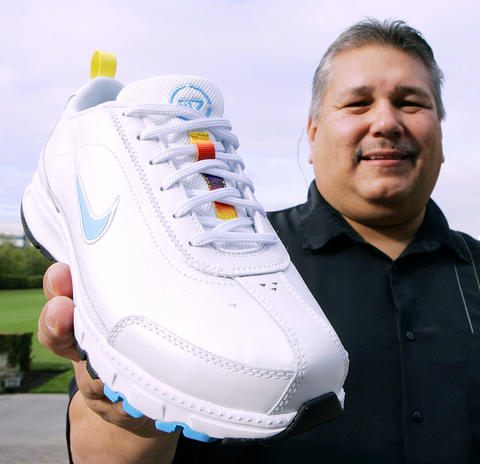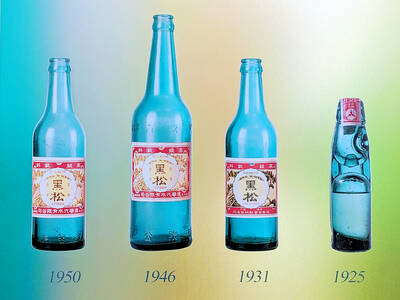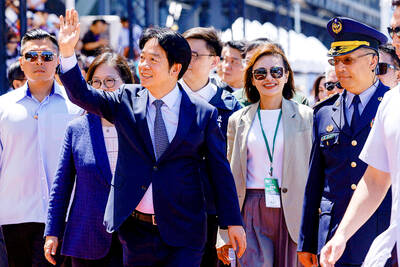This week, Nike unveiled what it said is the first shoe designed specifically for American Indians, an effort to promote physical fitness in a population with high obesity rates.
The company says the Air Native N7 is designed with a larger fit for the distinct foot shape of American Indians and has a culturally specific look. It will be distributed solely to American Indians; tribal wellness programs and tribal schools across the US will be able to buy the shoe at wholesale price and then pass it along to individuals, often at no cost.
"Nike is aware of the growing health issues facing Native Americans," said Sam McCracken, manager of Nike's Native American business program. "We are stepping up our commitment ... to elevate the issue of Native American health and wellness." Nike said it is the first time it has designed a shoe for a specific race or ethnicity. It said all profits from the sale of the shoe will be reinvested in health programs for tribal areas, where problems with obesity, diabetes and related conditions are near epidemic levels in some tribes.

PHOTO: AP
Nike designers and researchers looked at the feet of more than 200 people from more than 70 tribes nationwide and found that in general, American Indians have a much wider and taller foot than the average shoe accommodates. The average shoe width of men and women measured was three width sizes larger than the standard Nike shoe.
As a result, the Air Native is wider with a larger toe box. The shoe has fewer seams that can irritate and a thicker sock liner for comfort.
Jerry Bread, outreach coordinator for the Native American Studies program at University of Oklahoma, said the idea was "fantastic" and addressed a core issue for tribes, though he was skeptical that the feet of people from so many tribes could be so similar.
"It's an excellent gesture and I know it will get a lot of support from tribal people," Bread said. "We stand to profit from it in our physical health and well being."
Kelly Acton, director of the national diabetes program for Indian Health Services, said she was dubious of working with a corporation at first but said she was delighted with the result, saying Nike "bent over backwards" to design a shoe and respect public health needs.
The N7 name is a reference to the seventh generation theory, used by some tribes to look to the three generations preceding them for wisdom and the three generations ahead for their legacy.
The design features several "heritage callouts" as one product manager described it, including sunrise to sunset to sunrise patterns on the tongue and heel of the shoe. Feather designs adorn the inside and stars are on the sole to represent the night sky.
The company anticipates selling at least 10,000 pairs and raising US$200,000 for tribal programs. At US$42.80 wholesale, it represents less of a financial opportunity than a goodwill and branding effort.
"The reason I like it is that, even if there's not a big Native American market, it gives people the impression there is a constituency that deserves attention," said John Dickson, a member of the executive council of the Native American Leadership Alliance.

The unexpected collapse of the recall campaigns is being viewed through many lenses, most of them skewed and self-absorbed. The international media unsurprisingly focuses on what they perceive as the message that Taiwanese voters were sending in the failure of the mass recall, especially to China, the US and to friendly Western nations. This made some sense prior to early last month. One of the main arguments used by recall campaigners for recalling Chinese Nationalist Party (KMT) lawmakers was that they were too pro-China, and by extension not to be trusted with defending the nation. Also by extension, that argument could be

Aug. 4 to Aug. 10 When Coca-Cola finally pushed its way into Taiwan’s market in 1968, it allegedly vowed to wipe out its major domestic rival Hey Song within five years. But Hey Song, which began as a manual operation in a family cow shed in 1925, had proven its resilience, surviving numerous setbacks — including the loss of autonomy and nearly all its assets due to the Japanese colonial government’s wartime economic policy. By the 1960s, Hey Song had risen to the top of Taiwan’s beverage industry. This success was driven not only by president Chang Wen-chi’s

Last week, on the heels of the recall election that turned out so badly for Taiwan, came the news that US President Donald Trump had blocked the transit of President William Lai (賴清德) through the US on his way to Latin America. A few days later the international media reported that in June a scheduled visit by Minister of National Defense Wellington Koo (顧立雄) for high level meetings was canceled by the US after China’s President Xi Jinping (習近平) asked Trump to curb US engagement with Taiwan during a June phone call. The cancellation of Lai’s transit was a gaudy

The centuries-old fiery Chinese spirit baijiu (白酒), long associated with business dinners, is being reshaped to appeal to younger generations as its makers adapt to changing times. Mostly distilled from sorghum, the clear but pungent liquor contains as much as 60 percent alcohol. It’s the usual choice for toasts of gan bei (乾杯), the Chinese expression for bottoms up, and raucous drinking games. “If you like to drink spirits and you’ve never had baijiu, it’s kind of like eating noodles but you’ve never had spaghetti,” said Jim Boyce, a Canadian writer and wine expert who founded World Baijiu Day a decade